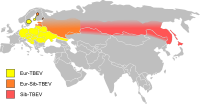
Photo from wikipedia
Since 2018, autochthonous West Nile virus (WNV) infections have been regularly reported in eastern–central Germany. While clinically apparent infections in humans and horses are not frequent, seroprevalence studies in horses… Click to show full abstract
Since 2018, autochthonous West Nile virus (WNV) infections have been regularly reported in eastern–central Germany. While clinically apparent infections in humans and horses are not frequent, seroprevalence studies in horses may allow the tracing of WNV and related flaviviruses transmission, such as tick-borne encephalitis virus (TBEV) and Usutu virus (USUV), and consequently help to estimate the risk of human infections. Hence, the aim of our study was to follow the seropositive ratio against these three viruses in horses in Saxony, Saxony Anhalt, and Brandenburg and to describe their geographic distribution for the year 2021. In early 2022, i.e., before the virus transmission season, sera from 1232 unvaccinated horses were tested using a competitive pan-flavivirus ELISA (cELISA). In order to estimate the true seropositive ratio of infection with WNV, TBEV, and USUV for 2021, positive and equivocal results were confirmed by a virus neutralization test (VNT). In addition, possible risk factors for seropositivity using questionnaires were analyzed using logistic regression based on questionnaires similar to our previous study from 2020. In total, 125 horse sera reacted positive in the cELISA. Based on the VNT, 40 sera showed neutralizing antibodies against WNV, 69 against TBEV, and 5 against USUV. Three sera showed antibodies against more than one virus, and eight were negative based on the VNT. The overall seropositive ratio was 3.3% (95% CI: 2.38–4.40) for WNV, 5.6% (95% CI: 4.44–7.04) for TBEV, and 0.4% (95% CI: 0.14–0.98) for USUV infections. While age and number of horses on the holding were factors predicting TBEV seropositivity, no risk factors were discovered for WNV seropositivity. We conclude that horses are useful sentinels to determine the flavivirus circulation in eastern–central Germany, as long as they are not vaccinated against WNV.
Journal Title: Viruses
Year Published: 2023
Link to full text (if available)
Share on Social Media: Sign Up to like & get
recommendations!